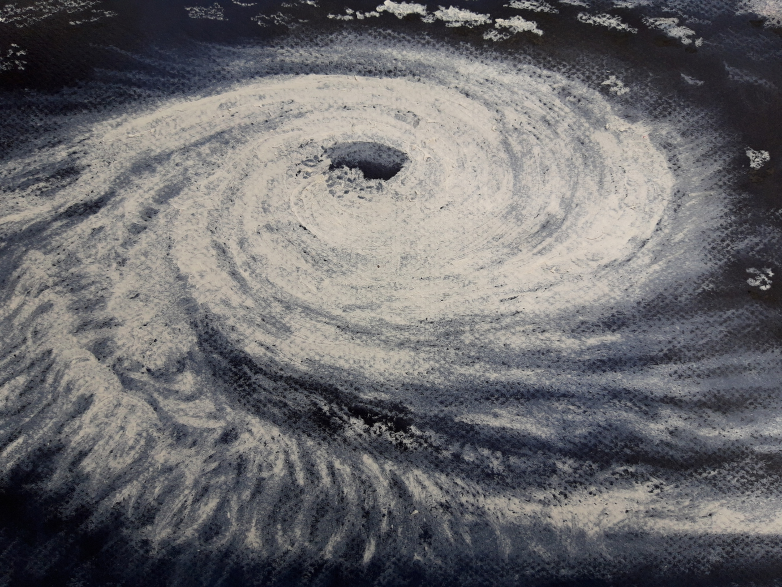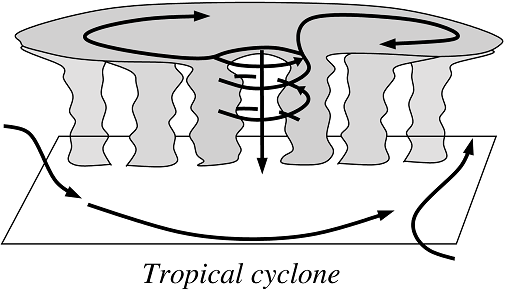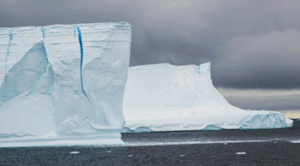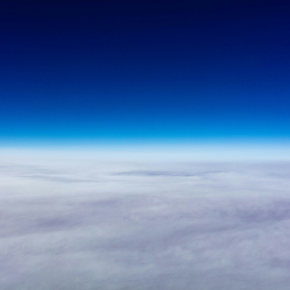Tropical cyclone
A tropical cyclone is an immense mass of clouds, stretching from 500 to 1 000 kilometres, mainly composed of storm cells. It carries gale-force winds, torrential rain, risks of floods and marine submersion events. With climate change, it is likely that cyclones would intensify with even greater damages.

Tropical cyclone, oil pastel by Camille Risi from a free of rights photograph.
Specific features
Easily recognisable by the major damages it causes. From the sky, it is a colossal spiralling cloud structure, with at its centre an area of clear sky, windless, of a few dozen kilometres: the eye of the storm.
Origin
 Cyclones are created from a tropical depression: an area containing numerous storms around which winds are turning. With the rotation of the Earth, air masses that converges toward the depression are deviated, to their right in the Northern hemisphere and to their left in the Southern hemisphere. This is called the Coriolis effect. That way, winds turn counter-clockwise around tropical depressions in the North, and clockwise in the South. As in a funnel, a swirl is created around the depression. As the depression deepens, winds get stronger and facilitate evaporation from the ocean. Moister, the air ascends more easily in updrafts, which gather around the minimum of pressure at the centre of the cyclone, creating “the wall”, an area of highly intense rainfall. At the centre, in the eye of the storm, the air flow goes downward and the weather is calm. And around the wall, storms arrange themselves in spiralling bands.
Cyclones are created from a tropical depression: an area containing numerous storms around which winds are turning. With the rotation of the Earth, air masses that converges toward the depression are deviated, to their right in the Northern hemisphere and to their left in the Southern hemisphere. This is called the Coriolis effect. That way, winds turn counter-clockwise around tropical depressions in the North, and clockwise in the South. As in a funnel, a swirl is created around the depression. As the depression deepens, winds get stronger and facilitate evaporation from the ocean. Moister, the air ascends more easily in updrafts, which gather around the minimum of pressure at the centre of the cyclone, creating “the wall”, an area of highly intense rainfall. At the centre, in the eye of the storm, the air flow goes downward and the weather is calm. And around the wall, storms arrange themselves in spiralling bands.
Evolution
A cyclone can last several days, even a week. It disappears when one of its power sources is cut down. That can be when arriving over land or a colder sea surface, limiting the available moisture essential to its maintenance.
When to see it
Cyclones appear above tropical oceans in the summer, where the sea surface is warm. They are not found close to the equator, under 5° latitude, because the Coriolis force is too weak there to induce a rotation movement around the depression. They are called hurricanes in the Atlantic Ocean or Typhoon in the Pacific. Driven by trade winds blowing from the East to the West, cyclones travel to the West. This is the reason why regions affected by tropical cyclones are mainly located to the West of ocean basins, such as the Caribbean or the United States for the Atlantic, and Japan, China or the Philippines for the Pacific.
Did you know?
Since tropical cyclones are thermal machines in which the heat source is the ocean surface, the global warming induced by human activities favours more intense cyclones. In addition, the global warming might lead to the formation of cyclones at more temperate latitudes than what we observe today, bringing impacts to regions that are not used to it nowadays.





